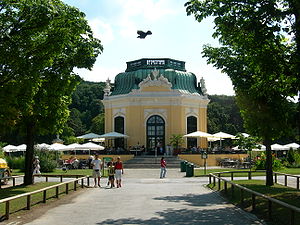Menagerie

Menagerie is the term for a historical form of keeping wild and exotic animals in human captivity and therefore a predecessor of the modern zoological garden. The term was foremost used in seventeenth century France originally for the management of the household or domestic stock, but later primarily for an aristocratic or royal animal collection. The French-language "Methodical Encyclopaedia" of 1782 defines a menagerie as an "establishment of luxury and curiosity." Later on the term was referred even to travelling animal collections that exhibited wild animals at fairs across Europe and the Americas.
Aristocratic menageries

A menagerie was mostly connected with an aristocratic or royal court and it was thus situated within a garden or park of a palace. The aristocratic menageries have to be distinguished from the later zoological gardens since they were founded and owned by aristocrats whose intention was not primarily of scientific and educational interest. These aristocrats wanted to illustrate their power and wealth, because exotic animals, alive and active, were less common, more difficult to acquire, and more expensive to maintain.
Medieval period and Renaissance
Already within the Middle Ages, several sovereigns across Europe maintained menageries at their royal courts. The most prominent animal collection in medieval England was the Tower Menagerie in London that began in 1235, during the reign of Henry III. In effect it was the royal menagerie of England for six centuries.
By the end of the fifteenth century, during the Renaissance period, the Italian aristocracy, wealthy patricians and clergymen, what eventually began to collect exotic animals at their residences on the outskirts of the cities. The role played by animals within the gardens of Italian villas expanded at the end of the sixteenth century, for which a remarkable sign was the Villa Borghese at Rome.
Versailles and its legacy

During the seventeenth century, when the palace of Versailles was built, Louis XIV of France also erected a menagerie within the palace’s park. Most of it was constructed in 1664 when the first animals were introduced, although the interior fittings were not finished until 1668-70. Situated in the south-west of the park, it was Louis XIV’s first major project at Versailles and one of several pleasure houses that were gradually assembled around the palace. It represented the first menagerie according to Baroque style. The prominent feature of Baroque menageries was the circular layout, in the middle of which stood a beautiful pavilion. Around this pavilion was a walking path and outside this path were the enclosures and cages. Each enclosure had a house or stable at the far end for the animals and was bounded on three sides with walls. There were bars only in the direction of the pavilion. This design was adopted by many other monarchs across Europe, particularly by the Habsburg monarchy in Austria. In 1752 Francis I erected his famous Baroque menagerie in the park of Schönbrunn Palace near Vienna.
In the nineteenth century the aristocratic menageries were displaced by the modern zoological gardens with their scientific and educational approach. Today, the only remaining menagerie is that of Tiergarten Schönbrunn, but in the twentieth century it evolved into a modern zoological garden with a scientific, educational and conservationist orientation. Due to its local continuity, the Vienna Zoo, the former menagerie, is often seen as the oldest remaining zoo in the world. Although many of the old Baroque enclosures have been changed, one can still obtain a good impression of the symmetrical ensemble of the formerly imperial menagerie.
Travelling menageries
In England travelling menageries had first appeared at the turn of the eighteenth century. In contrast to the aristocratic menageries, these travelling animal collections were run by showmen who met the craving for sensation of the ordinary population. These animal shows ranged in size but the largest was George Wombwell's. The earliest record of a fatality at one such travelling menagerie was the death of Hannah Twynnoy in 1703 who was killed by a tiger in Malmesbury, Wiltshire. Also in North America travelling menageries became ever more popular during that time.
The first exotic animal known to have been exhibited in America was a lion, in Boston in 1716, followed five years later in the same city by a camel. A sailor arrived in Philadelphia in August 1717 with another lion, which he exhibited in the city and surrounding towns for eight years. The first elephant was imported from India to America by a ship’s captain, Jacob Crowninshield, in 1796. It was first displayed in New York City and travelled extensively up and down the East Coast. In 1834 James and William Howes’ New York Menagerie toured New England with an elephant, a rhinoceros, a camel, two tigers, a polar bear, and several parrots and monkeys.
America’s touring menageries slowed to a crawl under the weight of the depression of the 1840s and then to a halt with the outbreak of the Civil War. Only one travelling menagerie of any size existed after the war: The Van Amburgh menagerie travelled the United States for nearly forty years. Unlike their European counterparts, America’s menageries and circuses had combined as single travelling shows, with one ticket to see both. This increased the size and the diversity of their collections. Ringling Bros. and Barnum & Bailey Circus advertised their shows as the “World’s Greatest Menagerie”.
Trivia
A menagerie is also the main focus of the pilot of Star Trek. [[1]]
References
- Hahn, Daniel (2003). The Tower Menagerie. London: Simon & Schuster. ISBN 0-7432-2081-1.
- Baratay, Eric (2002). Zoo: a History of the Zoological Gardens of the West. London: Reaktion. ISBN 1-86189-111-3.
{{cite book}}: Unknown parameter|coauthors=ignored (|author=suggested) (help)
External links
- Vienna Zoo
- La Ménagerie de Versailles (French)
